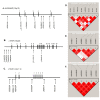The role of ALOX5AP, LTA4H and LTB4R polymorphisms in determining baseline lung function and COPD susceptibility in UK smokers
- PMID: 22206291
- PMCID: PMC3267686
- DOI: 10.1186/1471-2350-12-173
The role of ALOX5AP, LTA4H and LTB4R polymorphisms in determining baseline lung function and COPD susceptibility in UK smokers
Abstract
Background: We have previously shown evidence that polymorphisms within genes controlling leukotriene B4 (LTB4) production (ALOX5AP and LTA4H) are associated with asthma susceptibility in children. Evidence also suggests a potential role of LTB4 in COPD disease mechanisms including recruitment of neutrophils to the lung. The aim of the current study was to see if these SNPs and those spanning the receptor genes for LTB4 (LTB4R1 and LTB4R2) influence baseline lung function and COPD susceptibility/severity in smokers.
Methods: Eight ALOX5AP, six LTA4H and six LTB4R single nucleotide polymorphisms (SNPs) were genotyped in a UK Smoking Cohort (n = 992). Association with baseline lung function (FEV1 and FEV1/FVC ratio) was determined by linear regression. Logistic regression was used to compare smoking controls (n = 176) with spirometry-defined COPD cases (n = 599) and to more severe COPD cases (GOLD stage 3 and 4, n = 389).
Results: No association with ALOX5AP, LTA4H or LTB4R survived correction for multiple testing. However, we showed modest association with LTA4H rs1978331C (intron 11) with increased FEV1 (p = 0.029) and with increased FEV1/FVC ratio (p = 0.020).
Conclusions: These data suggest that polymorphisms spanning ALOX5AP, LTA4H and the LTB4R locus are not major determinants of baseline lung function in smokers, but provide tentative evidence for LTA4H rs1978331C (intron 11) in determining baseline FEV1 and FEV1/FVC ratio in Caucasian Smokers in addition to our previously identified role in asthma susceptibility.
© 2011 Tulah et al; licensee BioMed Central Ltd.
Figures

Similar articles
-
Leukotriene B4 receptor locus gene characterisation and association studies in asthma.BMC Med Genet. 2012 Nov 20;13:110. doi: 10.1186/1471-2350-13-110. BMC Med Genet. 2012. PMID: 23167751 Free PMC article.
-
The role of LTA4H and ALOX5AP polymorphism in asthma and allergy susceptibility.Allergy. 2008 Aug;63(8):1046-53. doi: 10.1111/j.1398-9995.2008.01667.x. Epub 2008 Jun 10. Allergy. 2008. PMID: 18547289
-
The role of LTA4H and ALOX5AP genes in the risk for asthma in Latinos.Clin Exp Allergy. 2010 Apr;40(4):582-9. doi: 10.1111/j.1365-2222.2009.03438.x. Epub 2010 Jan 11. Clin Exp Allergy. 2010. PMID: 20067482 Free PMC article.
-
PLAUR polymorphisms and lung function in UK smokers.BMC Med Genet. 2009 Oct 31;10:112. doi: 10.1186/1471-2350-10-112. BMC Med Genet. 2009. PMID: 19878584 Free PMC article.
-
COPD and genetics--what's new?Swiss Med Wkly. 2004 Aug 7;134(31-32):437-9. doi: 10.4414/smw.2004.10721. Swiss Med Wkly. 2004. PMID: 15389346 Review. No abstract available.
Cited by
-
Combining systems pharmacology, transcriptomics, proteomics, and metabolomics to dissect the therapeutic mechanism of Chinese herbal Bufei Jianpi formula for application to COPD.Int J Chron Obstruct Pulmon Dis. 2016 Mar 15;11:553-66. doi: 10.2147/COPD.S100352. eCollection 2016. Int J Chron Obstruct Pulmon Dis. 2016. PMID: 27042044 Free PMC article.
-
Water-Pipe Smoking Exposure Deregulates a Set of Genes Associated with Human Head and Neck Cancer Development and Prognosis.Toxics. 2020 Sep 18;8(3):73. doi: 10.3390/toxics8030073. Toxics. 2020. PMID: 32961854 Free PMC article.
-
Integrating Transcriptomics, Proteomics, and Metabolomics Profiling with System Pharmacology for the Delineation of Long-Term Therapeutic Mechanisms of Bufei Jianpi Formula in Treating COPD.Biomed Res Int. 2017;2017:7091087. doi: 10.1155/2017/7091087. Epub 2017 Mar 23. Biomed Res Int. 2017. PMID: 28424787 Free PMC article.
-
Integration of transcriptomics, proteomics, metabolomics and systems pharmacology data to reveal the therapeutic mechanism underlying Chinese herbal Bufei Yishen formula for the treatment of chronic obstructive pulmonary disease.Mol Med Rep. 2018 Apr;17(4):5247-5257. doi: 10.3892/mmr.2018.8480. Epub 2018 Jan 25. Mol Med Rep. 2018. PMID: 29393428 Free PMC article.
-
Identification of differentially expressed proteins in the injured lung from zinc chloride smoke inhalation based on proteomics analysis.Respir Res. 2019 Feb 15;20(1):36. doi: 10.1186/s12931-019-0995-0. Respir Res. 2019. PMID: 30770755 Free PMC article.
References
-
- Meyers DA, Larj MJ, Lange L. Genetics of asthma and COPD. Similar results for different phenotypes. Chest. 2004;126(2 Suppl):105S–110S. discussion 159S-161S. - PubMed
Publication types
MeSH terms
Substances
Grants and funding
LinkOut - more resources
Full Text Sources
Other Literature Sources
Medical
Miscellaneous

